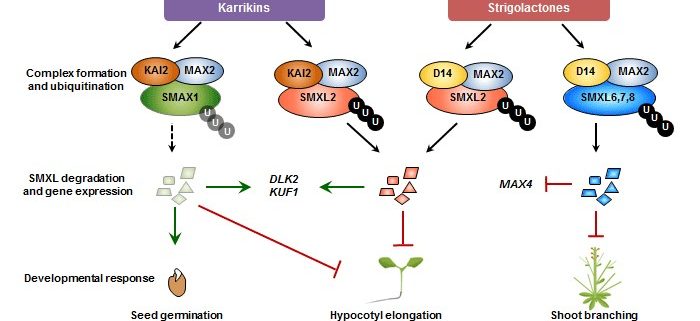Control of Arabidopsis Hypocotyl Growth by Strigolactone and Karrikin Signaling
Descriptive paragraph. Plant Cell https://doi.org/10.1105/tpc.20.00140
By Bing Wang and Qian Xu, Institute of Genetics and Developmental Biology, Chinese Academy of Sciences.
Background: Strigolactones (SLs) are carotenoid-derived plant hormones that control many aspects of plant development, such as shoot branching, internode elongation, leaf shape, root growth, anthocyanin accumulation, hypocotyl elongation and adaptive growth under diverse environments. Karrikins (KARs) are signaling molecules discovered in burned plant materials and regulate seed germination and seedling development. It has been generally considered that although SLs and KARs share similar chemical structures, they employ different SMXL family members for signal transduction in Arabidopsis thaliana. However, both synthetic SL analogs and synthetic KAR compounds could inhibit hypocotyl elongation and induce expression of the same downstream genes, raising the question of whether the SL and KAR signaling is convergent or parallel. In addition, although key components of KAR signaling have been identified through genetic analyses, the biochemical mechanism underlying KAR signaling remains elusive.
Question: Is there any SMXL protein that is involved in both SL and KAR signaling pathways, and if so, is it important for hypocotyl elongation and transcriptional regulation in response to SLs and KARs? Does KAR signaling employ a similar mechanism to SL signaling that relies on an F-box-mediated ubiquitination and degradation of the SMXL proteins?
Findings: We found that SMXL2 is involved in both SL and KAR signaling pathways. The SL-D14 and KAR-KAI2 receptor complexes both trigger the ubiquitination and degradation of SMXL2, dependent on SL and KAR ligands, respectively. SMXL2 plays critical roles in seedling photomorphogenesis and downstream gene expression commonly regulated by SLs and KARs. These discoveries elucidated a common molecular mechanism for SL and KAR signaling involving SMXL2 polyubiquitination and degradation, supporting the proposed evolution of SL signaling from an ancestral KAI2-SMAX1 system. Modulation of SMXL2 activity by both SL and KAR signaling potentially provides flexibility in photomorphogenic responses to diverse environmental factors in Arabidopsis seedlings.
Next steps: One interesting direction for future exploration is to elucidate the molecular mechanism underlying SMXL2- and SMAX1-mediated transcriptional regulation and hypocotyl elongation. Another interesting direction is investigation of the SL and KAR signaling in crop plants, which will provide new opportunities for future improvements in agriculture.




